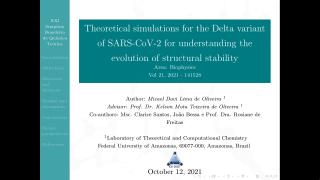Anais do Simpósio Brasileiro de Química Teórica
Proceedings of the XXI Brazilian Symposium on Theoretical Chemistry - Vol. 1 2021
IN SILICO PROSPECTING INHIBITORS GLUTAREDOXIN A1 OF CORYNEBACTERIUM PSEUDOTUBERCULOSIS
How to cite this paper?
To cite this paper use one of the standards below:
How to cite this paper?
- Presentation type: Apresentação de Pôster / Poster Communications
- Track: Biophysics
- Keywords: Homology modeling; molecular dynamics; Virtual Screening;
- 1 Universidade Federal de Mato Grosso do Sul
- 2 Universidade Federal do Tocantins
IN SILICO PROSPECTING INHIBITORS GLUTAREDOXIN A1 OF CORYNEBACTERIUM PSEUDOTUBERCULOSIS
Charlene Marcondes Avelar
Universidade Federal de Mato Grosso do Sul
Now you could share with me your questions, observations and congratulations
Create a topic- Presentation type: Apresentação de Pôster / Poster Communications
- Track: Biophysics
- Keywords: Homology modeling; molecular dynamics; Virtual Screening;
- 1 Universidade Federal de Mato Grosso do Sul
- 2 Universidade Federal do Tocantins
Caseous lymphadenitis (CL) is an infectious disease caused by the pathogenic microorganism Corynebacterium pseudotuberculosis (Cp) and causes great economic losses in livestock farming worldwide.
In this context, when understanding the aspects of bacterial defenses, in silico approaches can assist in inhibition strategies of this mechanism.
In summary, the present work aims to search for possible inhibitors of the GrxA1 protein of C. pseudotuberculosis, through computational simulations by Molecular Dynamics (DM) and Virtual Screening (VS).
The three-dimensional structure of GrxA1 was constructed by homology in its active form and, in sequence, simulated for 200 ns with the DM technique.
In the second stage, using molecular docking and Virtual Screening, we found a total of 26 molecules with the potential inhibitor of GrxA1.
Although still in the preliminary phase, the study paves the way for the development of new medicines and biotechnological applications, contributing to assist in the treatment and/or cure of Caseous Lymphadenitis, thus generating great interest for this sector of the economy.
pH utilizado e otimização dos ligantes
Vinícius Bonatto
Oi Charlene, bem legal essa proposta que vocês estão realizando. Você tem ideia de quanto seria o pH em ensaios enzimáticos? Pois você disse que checou os estados de protonação utilizando pH = 7.4. Vocês pretendem realizar otimização nesses ligantes também? Obrigado e parabéns pelo trabalho.
- 2 answers
Streamline your Scholarly Event
With nearly 200,000 papers published, Galoá empowers scholars to share and discover cutting-edge research through our streamlined and accessible academic publishing platform.
Learn more about our products:
How to cite this proceedings?
This proceedings is identified by a DOI , for use in citations or bibliographic references. Attention: this is not a DOI for the paper and as such cannot be used in Lattes to identify a particular work.
Check the link "How to cite" in the paper's page, to see how to properly cite the paper



Charlene Marcondes Avelar
Olá Vinícius,
O pH ótimo da proteína é esse 7.4, essa referência foi encontrada em um artigo experimental. Iremos fazer Dinamica Molecular com os 26 compostos, para uma análise do detalhamento do acoplamento proteína/ligante e depois partimos para a otimização somente com as interações de melhores resultados.
Vinícius Bonatto
Oi Charlene, muito obrigado pela resposta, ficou bem claro. Abraços.